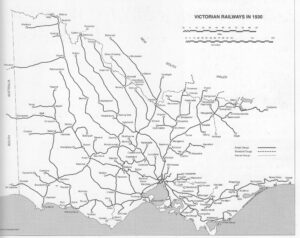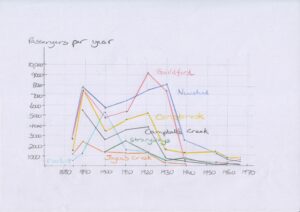In this final installment of a four part series tracing the history of the Castlemaine-Maryborough railway line, David Tuck looks at the early successful running followed by the slow and inevitable demise of the line.
Part 3 finished with Mark Twain’s scathing description of traveling on the line in 1895. It was part of a longer trip, famously published as The Wayward Tourist.
The engineers’ concerns about light lines proved to be right, and most were rebuilt with heavier rails during the 1890s. I’m not sure whether our line was ever completely upgraded, however in 1908 a local paper reported critically on the upgrading of the line at Campbell’s Creek to carry heavier engines, noting that the work had to be redone because nine rather than eight sleepers were needed per length of heavy rail. Similarly, some of the sharper curves in the line that were meant to save on construction costs were redone years later, notably on the northern approach to Guildford.
 The Victorian Railways network in 1930. Note the long extensions to lines through the Mallee, and, curiously, the Victorian Railways lines extending through the Riverina on the other side of the Murray River
The Victorian Railways network in 1930. Note the long extensions to lines through the Mallee, and, curiously, the Victorian Railways lines extending through the Riverina on the other side of the Murray River
Ticket prices. How affordable were train tickets, and how frequent were the services? Right from the start, there were two trains per day in each direction, morning and afternoon, along our line. The initial journey time in the 1870s of two hours and 15 minutes was an hour longer than it took in the 1960s.
In 1874, when a laborer typically earned £2 ($4) per week, the fare for a ticket from Castlemaine to Maryborough was 3/6d (35c), about one-twelfth of his weekly wage. Newstead to Maryborough cost two shillings (20 c), Melbourne to Castlemaine 8/6d (85c), Melbourne to Maryborough 12 shillings ($1.20) – almost a quarter of his weekly wage. You would have quickly gone broke doing a Melbourne commute to your job!
By 1963, Victorian Railways charged about nine shillings and sixpence (95c), 1.7% of a typical wage, to travel our line. In 2022, the fare was $7.20, or only 0.7% of a low wage – less than half the cost in real terms. Of course, if you didn’t have a living wage, then the cost of a ticket was still significant. Astonishingly, in 2023, a fare ceiling of about $10 per day for Victorian public transport was introduced. In earlier times, however, the cost was ‘prohibitive’.
Since this article is prompted by rail trails, you may be wondering what it cost to take your bike on the train. There’s no charge these days, although when I started cycle touring in the 1980s there was a flat rate of $5. In 1910, you were charged one shilling (10c) to bring your bike with you from Melbourne to Castlemaine, or 6 pence(5c) if the journey was less than fifty miles. Freeloaders were warned that “bicycles with extra parts attached are charged Parcels Rate, plus 50 per cent.” Another by-law warned that even if you removed the handlebars and pedals and concealed your bike in a box, disguised as free baggage, you would be caught and liable for the full rates, as prescribed.
 This picture shows Francis Birtles, the first person to ride a bicycle east to west across Australia. This is one way to avoid a bicycle surcharge!
This picture shows Francis Birtles, the first person to ride a bicycle east to west across Australia. This is one way to avoid a bicycle surcharge!
 How many people used the train service as passengers? If you map ticket sales at each station (excluding Castlemaine and Maryborough, as the tickets could be for anywhere), you can see buoyant numbers right through to about 1930. In 1921, there were about 9,200 passengers per year (or 25 per day, on average) setting out from Guildford, and about 7,500 from Newstead.
How many people used the train service as passengers? If you map ticket sales at each station (excluding Castlemaine and Maryborough, as the tickets could be for anywhere), you can see buoyant numbers right through to about 1930. In 1921, there were about 9,200 passengers per year (or 25 per day, on average) setting out from Guildford, and about 7,500 from Newstead.
But by 1966, the last year for which detailed statistics were published, passenger numbers ranged from an average of one per fortnight at Strangways, to a bit over two per day at Carisbrook. The service was fading with barely a whimper!
The number of rail cars of livestock went into free fall after WW2. The carriage of general freight gave better returns from some stations, most notably Moolort, Carisbrook and Newstead. Crushed quartz and gravel, grain, firewood, eggs and chaff were some of the goods shipped in significant tonnage.
There is still much to be gained from learning about our railway. The fascinating rhythms of railway expansion and decline in Victoria over the decades are worthy of further investigation.
The railway line from Castlemaine to Maryborough operated scheduled services for 103 years, 3 weeks and 3 days, closing on 31 July 1977.
Let’s finish with a photo of the Maryborough railway station and yard, taken around 1910. There’s a lot happening in this photo – it’s worth a close look.

